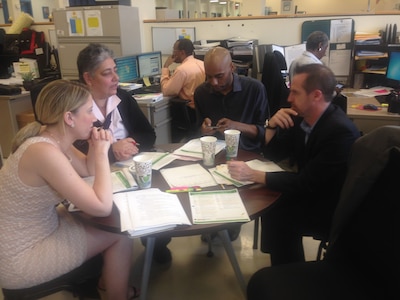This is the first in a series of stories for our first Raise Your Hand investigation based on the reader-selected question, “Is there a building that houses many schools that are working particularly well together? How are the schools collaborating?”
In the Williamsbridge neighborhood of the Bronx, a thousand middle schoolers stream into the Richard R. Green campus every day. Then they divide into four similar schools, each trying to raise students’ scores while grappling with the personal challenges they bring into the building.
But when Mayor Bill de Blasio announced the start of New York City’s “Renewal” school turnaround program last fall, which promised to flood some schools with new resources, just three of the building’s four schools were included.
It makes for a potentially awkward situation at Richard R. Green, where the School of Diplomacy, Young Scholars Academy, Globe School for Environmental Research, and Forward School of Creative Writing have been sharing a three-story building since 2007. Across the city, co-located principals have to manage scarce resources like gym and cafeteria space. In some schools, the controversial space-sharing policy leads to hostility, especially when school leaders feel like their students have access to less than their peers.
These four leaders say they’re determined not to let the recent changes undermine their collaboration.
“We want to make sure that we’re having conversations and we’re not leaving a quarter of the building out,” said Sean Licata, who just finished his third year as principal of the School of Diplomacy, one of the schools in the turnaround program. “How do we always make sure we’re including our non-Renewal school that we’re already working with?”
The four schools serve similar students. Nearly all are black or Hispanic and come from low-income families, and about a quarter have special needs. The schools are also all battling similar problems: attendance that hovers below 90 percent, and less than 10 percent met state standards for reading proficiency in 2014.
The three Renewal schools have also seen declining enrollment over the last two years. The Globe School, for example, dropped nearly 140 students between 2011 and 2013, enrolling fewer than 300 last year.
In their efforts to fix that, the schools have found ways to work together over time. They share some staff members, including a foreign language teacher, a speech teacher, and gym teachers. A campus-wide lunch on the the first day of school is designed to show students and teachers that they are working together.

The four principals sat down together to set their budgets for the upcoming school year and looked for ways to share resources. That conversation took on new weight this year, since the three Renewal schools are receiving extra funding from the city, a new community partnership, mental health support, an additional hour of learning time, and other help. (The city has said it expects all schools in buildings with Renewal schools to share some of those benefits, like new access to health clinics, even if they aren’t receiving extra money in their budgets.)
As she helps the schools plan to use those new resources, the director of the Renewal program for District 11 said she is also making a conscious effort to keep Magdalen Neyra, the principal of the Forward School, which is not in the turnaround program, in the loop.
“I’m hoping it’s going to trickle down to her,” the director, Juanita Rodriguez, said. “We wish we had extra money to give her — we’re sitting at the budget meeting and she’s the only one struggling with her budget. She’s a trooper.”
The schools have helped fill in gaps for one another in the past. Last year, one received funding to have a nonprofit provide after-school programming, and Licata’s students were invited to participate, even though his school couldn’t cover the cost.
This coming year, his school will be giving up a classroom to serve as headquarters for Phipps Community Development Corporation, an organization partnering with all three Renewal schools.
Neyra, the first-year principal of the Forward School, said their efforts have been helpful at making sure she doesn’t feel like “the lonely principal” in the building.
“There are so many requirements for our job and it’s very easy to just focus on your school,” she said. “You have to almost force yourself to make that a priority.”
Not all of their efforts to unify the school have stuck. Last year, the principals standardized their bell schedules to make it easier for the staff members they share to switch between schools. The extra hour of learning time that the three Renewal schools will add next year meant they had to change that.
They are, however, planning to continue their method of ensuring teachers from different schools spend time in one another’s classrooms.
The principals identified teachers with a range of strengths — an English teacher who had organized student book clubs was one, and a teacher especially skilled at provoking thoughtful student discussions was another — and encouraged others from other schools and grade levels to visit.
“We’re competitive, but it’s not a competition,” Licata said.
“This is a building that has had years of negative reputation, and there’s only one way that reputation can get changed,” he added. “We’re all going to have to do it together.”
This is the first in a series of stories that will highlight co-locations that are working (and some that aren’t). Ask your own question about New York City schools here, and it could turn into our next Raise Your Hand investigation.


